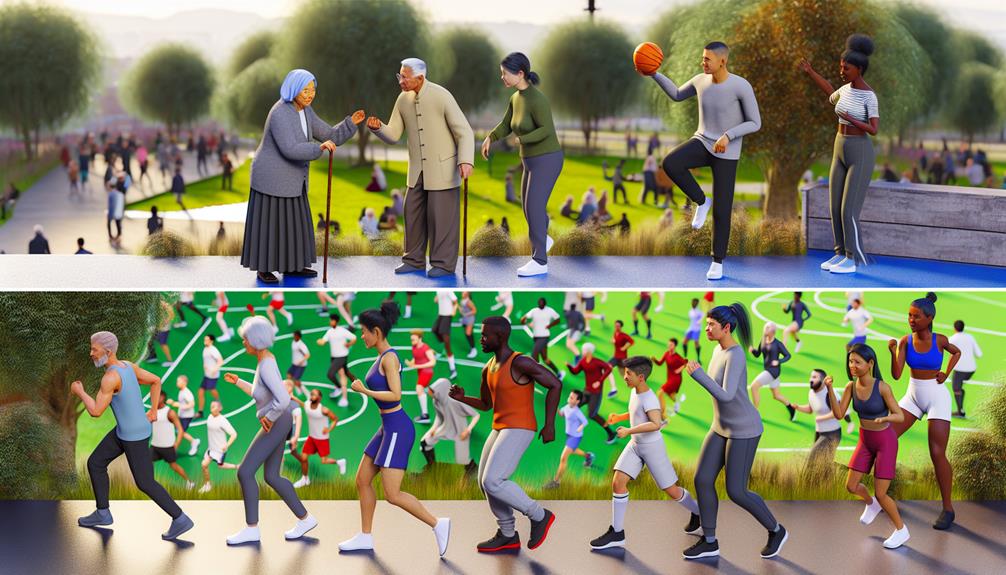You won't believe the incredible impact that fitness initiatives can have on local neighborhoods. From increased access to state-of-the-art facilities to the numerous health benefits for residents, the transformation is truly remarkable. But it doesn't stop there. The ripple effects of these initiatives extend far beyond physical fitness, fostering social connections, revitalizing public spaces, and even driving economic growth. So, let's dive into this discussion and uncover the surprising ways that fitness can shape and uplift our communities.
Key Takeaways
- Increased access to fitness facilities is crucial for making fitness accessible to everyone, and affordable options and infrastructure improvements are needed to break down financial barriers.
- Regular exercise has numerous health benefits, including improving physical fitness, mental wellbeing, and reducing healthcare costs.
- Engaging in fitness activities fosters social connections and community engagement, creating an inclusive environment and encouraging active participation in local events.
- Revitalizing public spaces through fitness initiatives not only creates vibrant gathering spots but also promotes a sense of pride and belonging in the neighborhood while contributing to economic growth and supporting local businesses.
Increased Access to Fitness Facilities
When it comes to improving the fitness levels of local neighborhoods, one key factor is increasing access to fitness facilities. Affordable options and infrastructure improvements play a vital role in making fitness accessible to everyone.
Imagine living in a neighborhood where there are no affordable fitness options nearby. It can be disheartening and demotivating, especially when you're trying to make positive changes in your health and well-being. However, by increasing access to fitness facilities, we can transform communities and empower individuals to take charge of their fitness journeys.
Affordable options are crucial in ensuring that fitness facilities are accessible to people from all walks of life. By offering memberships at reasonable prices and providing discounted rates for low-income individuals and families, we can break down financial barriers and make fitness a reality for everyone. No one should be denied the opportunity to improve their health due to financial constraints.
Infrastructure improvements also play a significant role in increasing access to fitness facilities. By investing in the development of community centers, parks, and recreation areas, we create spaces where people can engage in physical activities and lead active lifestyles. Having well-maintained sidewalks, bike lanes, and public transportation options also encourages people to incorporate exercise into their daily routines.
Health Benefits for Residents
Residents of neighborhoods with increased access to fitness facilities experience a wide range of health benefits that positively impact their overall well-being. Regular exercise not only improves physical fitness but also contributes to mental wellbeing, reduces healthcare costs, and promotes a sense of community. Here are four key health benefits that residents can enjoy:
- Improved Mental Wellbeing: Engaging in physical activity releases endorphins, which are known as "feel-good" hormones. Regular exercise can reduce symptoms of depression, anxiety, and stress, improving overall mental health and promoting a positive mindset.
- Reduced Healthcare Costs: By incorporating exercise into their daily routines, residents can lower their risk of developing chronic diseases such as obesity, heart disease, and diabetes. This, in turn, leads to reduced healthcare costs, as fewer medical interventions and medications are required.
- Increased Energy Levels: Regular physical activity boosts energy levels and combats fatigue. Residents who exercise regularly are more likely to experience increased productivity and improved quality of life.
- Enhanced Community Bonding: Fitness facilities provide a space for residents to come together, connect, and support each other on their wellness journeys. Engaging in group fitness classes or participating in community events fosters a sense of belonging and strengthens the social fabric of the neighborhood.
Social Connections and Community Engagement

As you explore the impact of fitness on local neighborhoods, you'll discover that beyond the health benefits, social connections and community engagement play a crucial role in enhancing the overall well-being of residents. Engaging in fitness activities not only improves physical fitness but also contributes to mental well-being. When you participate in group exercise classes or join a local sports team, you have the opportunity to interact with like-minded individuals who share similar goals and interests. These social connections provide a support system that can boost your motivation and accountability, making it easier to stick to your fitness routine.
Furthermore, fitness initiatives in local neighborhoods foster social cohesion. They bring residents together, breaking down barriers and creating an inclusive environment. Whether it's a neighborhood walking group, a community sports event, or a fitness challenge, these activities encourage interaction and collaboration among residents. The shared experience of working towards common fitness goals strengthens the sense of belonging and unity within the community.
Community engagement through fitness initiatives also has a ripple effect on the overall well-being of the residents. It encourages active participation in local events and fosters a sense of pride and ownership in the neighborhood. The increased social connections and community engagement that result from fitness activities create a positive feedback loop, leading to a happier and healthier community.
Revitalizing Public Spaces
To breathe new life into public spaces, consider implementing revitalization projects that encourage community interaction and create vibrant gathering spots for residents. By transforming neglected areas into vibrant hubs of activity, you can foster a sense of pride and belonging within your neighborhood. Here are four ways to revitalize public spaces and make them more engaging for the community:
- Urban Gardening: Create community gardens where residents can come together to grow their own fruits, vegetables, and flowers. Not only does this promote healthy eating and sustainability, but it also provides a space for neighbors to connect and share gardening tips.
- Active Transportation: Designate bike lanes and pedestrian-friendly paths that encourage residents to walk or cycle instead of relying on cars. This not only reduces traffic congestion and pollution but also promotes a healthier and more active lifestyle.
- Art Installations: Install public art pieces that reflect the unique identity and culture of your neighborhood. These installations can be a source of inspiration and pride for residents while also attracting visitors from outside the community.
- Interactive Play Spaces: Create outdoor play areas that cater to people of all ages. Install fitness equipment, playgrounds, and seating areas where families and individuals can gather, exercise, and socialize.
Economic Impact and Local Business Growth

By creating vibrant public spaces that encourage community interaction and promote a healthier and more active lifestyle, you can also have a significant economic impact and foster local business growth within your neighborhood. When people come together in these spaces to engage in fitness activities, it not only benefits their health but also stimulates the local economy.
One of the ways fitness initiatives contribute to economic growth is through job creation. As more people participate in fitness programs and activities, the demand for fitness instructors, personal trainers, and other fitness-related professionals increases. This, in turn, creates employment opportunities for individuals within the community, reducing unemployment rates and improving overall economic stability.
In addition to job creation, fitness initiatives also support the growth of small businesses. Local gyms, fitness studios, and wellness centers often depend on the support of the community to thrive. By promoting a culture of fitness and encouraging community members to patronize these establishments, you can help sustain and grow these small businesses. This not only boosts the local economy but also fosters a sense of pride and ownership within the community.
Furthermore, the economic impact of fitness initiatives extends beyond fitness-related businesses. Increased foot traffic in public spaces and the presence of active individuals can attract other businesses to the neighborhood. Restaurants, cafes, and shops may see an increase in customers as people gather before or after their fitness activities. This symbiotic relationship between fitness initiatives and local businesses creates a thriving and vibrant community.
Frequently Asked Questions
How Can Community Initiatives for Fitness Help to Address Social Inequalities in Local Neighborhoods?
Promoting inclusivity and overcoming barriers, community fitness initiatives can address social inequalities in local neighborhoods. By providing accessible programs and resources, they create opportunities for all residents to improve their health and well-being.
What Are Some Innovative Ways That Community Initiatives Are Using Technology to Promote Fitness in Local Neighborhoods?
You can't talk about the future of community fitness initiatives without mentioning technology. It's changing the game, engaging the unengaged and promoting fitness in local neighborhoods like never before.
Are There Any Specific Programs or Initiatives That Target Vulnerable Populations, Such as Low-Income Individuals or Seniors, to Improve Their Access to Fitness Facilities?
Improving access to fitness facilities for low-income individuals and seniors is essential. Programs and initiatives specifically target these vulnerable populations, providing affordable memberships, transportation, and specialized classes to ensure everyone can prioritize their health and well-being.
How Do Community Initiatives for Fitness Contribute to Overall Community Well-Being and Quality of Life?
Community initiatives for fitness promote overall community well-being and quality of life. Through community engagement and addressing health disparities, these initiatives provide access to fitness facilities and programs that improve physical and mental health.
Are There Any Challenges or Barriers That Community Initiatives Have Faced in Implementing and Sustaining Fitness Programs in Local Neighborhoods?
You'll face challenges and barriers when implementing and sustaining fitness programs in local neighborhoods. It's not easy, but with determination and creativity, you can overcome them and make a positive impact on the community's well-being.
Conclusion
In conclusion, community fitness initiatives have proven to be a game-changer for local neighborhoods. With increased access to fitness facilities, residents are benefiting from improved health, social connections, and revitalized public spaces. Not to mention the positive economic impact and local business growth. So lace up your sneakers, join the movement, and let's shape our neighborhoods into healthier, stronger, and more vibrant communities. It's time to break a sweat and make a difference!













